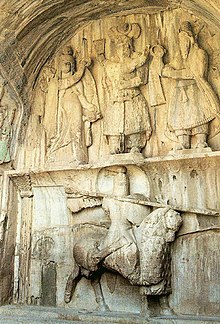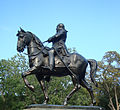Equestrian statue: Difference between revisions
m WP:CHECKWIKI error fix for #48. Remove link to the title inside the text. Do general fixes if a problem exists. - using AWB (10361) |
→Medieval Europe: gallery |
||
| Line 23: | Line 23: | ||
===Medieval Europe=== |
===Medieval Europe=== |
||
Equestrian statues were not very frequent in the [[Middle ages]]. Nevertheless, there are some examples, like the [[Bamberg Horseman]] (German: ''Der Bamberger Reiter''), located in [[Bamberg Cathedral]]. Another example is the ''Magdeburg Reiter'', in the city of [[Magdeburg]], that depicts Emperor [[Otto I]]. There are a few roughly half-size statues of ''[[Saint George and the Dragon]]'', including the famous ones in [[Prague]] and [[Stockholm]]. The [[Scaliger Tombs]] in [[Verona]] include Gothic statues at less than lifesize. A well-known small bronze in Paris may be a contemporary portrait of [[Charlemagne]], although its date and subject are uncertain. |
Equestrian statues were not very frequent in the [[Middle ages]]. Nevertheless, there are some examples, like the [[Bamberg Horseman]] (German: ''Der Bamberger Reiter''), located in [[Bamberg Cathedral]]. Another example is the ''Magdeburg Reiter'', in the city of [[Magdeburg]], that depicts Emperor [[Otto I]]. There are a few roughly half-size statues of ''[[Saint George and the Dragon]]'', including the famous ones in [[Prague]] and [[Stockholm]]. The [[Scaliger Tombs]] in [[Verona]] include Gothic statues at less than lifesize. A well-known small bronze in Paris may be a contemporary portrait of [[Charlemagne]], although its date and subject are uncertain. |
||
<gallery> |
|||
Bamberger Reiter BW 1.JPG|Bamberg horseman (1225-37), Bamberg |
|||
Alter Markt (Magdeburg-Altstadt).Magdeburger Reiter.ajb.jpg|Magdeburg horseman (1240), Magdeburg |
|||
Sv. Jiří a drak.jpg|St. George and dragon (1373), Prague |
|||
Riemenschneider Hl Georg.jpg|thumb|Tilman Riemenschneider: Hl Georg (1490-95)]] |
|||
<gallery/> |
|||
===Renaissance=== |
===Renaissance=== |
||
Revision as of 10:47, 17 August 2014

An equestrian statue is a statue of a rider mounted on a horse, from the Latin "eques", meaning "knight", deriving from "equus", meaning "horse".[1] A statue of a riderless horse is strictly an "equine statue". A full-size equestrian statue is a difficult and expensive object for any culture to produce, and figures have typically been portraits of rulers or, more recently, military commanders.
History

Ancient Greece
Equestrian statuary in the West goes back at least as far as Archaic Greece. Found on the Athenian acropolis, the sixth century BC statue known as the Rampin Rider depicts a kouros mounted on horseback.
Ancient Middle and Far East
A number of ancient Egyptian, Assyrian and Persian reliefs show mounted figures, usually rulers, though no free standing statues are known. The Chinese Terracotta Army has no mounted riders, though cavalrymen stand beside their mounts, but smaller Tang Dynasty pottery tomb Qua figures often include them, at a relatively small scale. No Chinese portrait equestrian statues were made until modern times; statues of rulers are not part of traditional Chinese art, and indeed even painted portraits were only shown to high officials on special occasions until the 11th century.[2]
Ancient Rome

Such statues frequently commemorated military leaders, and those statesmen who wished to symbolically emphasize the active leadership role undertaken since Roman times by the equestrian class, the equites (plural of eques) or knights.
There were numerous bronze equestrian portraits (particularly of the emperors) in ancient Rome, but they did not survive because they were melted down for reuse of the alloy as coin, church bells, or other, smaller projects (such as new sculptures for Christian churches); the standing Colossus of Barletta lost parts of his legs and arms to Dominican bells in 1309. Almost the only sole surviving Roman equestrian bronze, the equestrian Statue of Marcus Aurelius in Rome, owes its preservation on the Campidoglio, to the popular mis-identification of Marcus Aurelius, the philosopher-emperor, with Constantine the Great, the Christian emperor.

The Regisole ("Sun king") was a bronze classical or Late Antique equestrian monument of a ruler, highly influential during the Italian Renaissance but destroyed in 1796 in the wake of the French Revolution. It was originally erected at Ravenna, but removed to Pavia in the Middle Ages, where it stood on a column before the cathedral. A fragment of an equestrian portrait sculpture of Augustus has also survived.
Medieval Europe
Equestrian statues were not very frequent in the Middle ages. Nevertheless, there are some examples, like the Bamberg Horseman (German: Der Bamberger Reiter), located in Bamberg Cathedral. Another example is the Magdeburg Reiter, in the city of Magdeburg, that depicts Emperor Otto I. There are a few roughly half-size statues of Saint George and the Dragon, including the famous ones in Prague and Stockholm. The Scaliger Tombs in Verona include Gothic statues at less than lifesize. A well-known small bronze in Paris may be a contemporary portrait of Charlemagne, although its date and subject are uncertain.
-
Bamberg horseman (1225-37), Bamberg
-
Magdeburg horseman (1240), Magdeburg
-
St. George and dragon (1373), Prague
-
Tilman Riemenschneider: Hl Georg (1490-95)]]
-
Anna Salai in Anna Flyover Chennai, one of the most famous place in Chennai. His statue used for Horse Racing
-
Kemal Atatürk by Krippel in Ankara, Turkey
Australia
-
Boer War Memorial, Brisbane
Europe
-
Equestrian statue at Vitkov Hill of Jan Žižka from of Trocnov and the Chalice) (c. 1360–1424), Czech general and Hussite leader, Prague, Czech Republic
-
Statue of Archduke Karl in Vienna's Heldenplatz, the largest in the world with only two support points
-
Statue of Richard I, Westminster
-
Statue of August the Strong ("Golden Horseman"), Dresden
-
Statue of William the Silent in The Hague
-
Statue of Theodoros Kolokotronis in Athens
-
Statue of King Svätopluk I at Bratislava Castle
-
Statue of King Tomislav in Zagreb
North America
-
Statue of King Edward VII, Queen's Park, Toronto. This statue was originally placed in Delhi, India in 1919 but was moved to Canada in 1969.
South America
-
Statue of Simon Bolivar in Santa Marta
-
Statue of Duke of Caxias in São Paulo
-
Monument to Pedro I of Brazil in Rio de Janeiro
External links
- Equestrian statues in Washington, D.C. (with pictures)
References
- ^ Wheelock, Frederic M., The Official Wheelock's Latin Website, retrieved 2009-04-03
- ^ Stuart, Jan & Rawski, Evelyn Sakakida. Worshiping the ancestors: Chinese commemorative portraits, Stanford University Press, 2001, ISBN 0-8047-4263-4, ISBN 978-0-8047-4263-4




![Tilman Riemenschneider: Hl Georg (1490-95)]]](http://upload.wikimedia.org/wikipedia/commons/thumb/3/3a/Riemenschneider_Hl_Georg.jpg/90px-Riemenschneider_Hl_Georg.jpg)









































